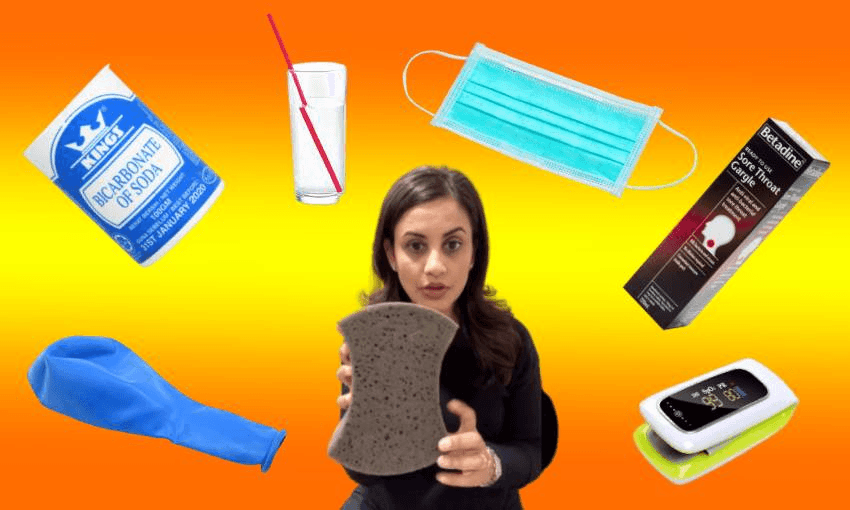By day, she’s a GP in a Grey Lynn clinic. By night (and at weekends), Dr Sandhya Ramanathan is a WhatsApp and YouTube superstar.
Two months ago, Sandhya Ramanathan began posting videos on how to manage Covid-19 at home. They were made for her family overseas, in countries where managing the virus was difficult: the UK, US and India.
One went, pardon the pun, viral. She filmed the 18-minute video in one take, trying to get out the key messages before she got onto packing her son’s bag for school camp. Her legs were asleep by the end of it. Today, that video has almost 360,000 views on YouTube and millions on WhatsApp, where it was shared first with Ramanathan’s cousins and then with the rest of the world, desperate for a way to prepare for the pandemic.
She’d been looking into ways to treat Covid-19 at home because she knew this is where most people would be dealing with it. One way to save lives – both directly and by reducing the strain on hospitals – is to keep mild cases mild, instead of letting them get worse. “You have to actively treat it, you can’t just lie down in bed,” says Ramanathan.
When she made the video, she took care to outline methods of treatment that didn’t involve trips to the doctor or expensive equipment. “I’m just thinking of the people in India, who have no access to a doctor,” she says.
She ascribes the video’s popularity to that classic GP technique: calmly explaining the physiology of what’s going on. No scaremongering. “It’s how you say it. I’m not saying in my video that you have to take this medication. All I’m saying is that there are medications you can use,” she says.
“If doctors know, laypeople should know.”
Her tips include analogies, so the whole Covid-19 phenomenon can be understood. “I’ve made it so a five-year-old can understand,” she says. One of the most popular is a boxing ring analogy.
“The person infected in the house is in a fight with Covid-19, like in a boxing ring. Everyone else is on the outside of that ring. They’re still providing for whatever they need – medication, bring it to the side – but from that safe distance.”
Ramanathan’s guide to treating a mild case of Covid-19 is, roughly, broken into three sections: priming your immune system, increasing your oxygen saturation, and reducing viral load. When she explains them, they seem like common sense.
Priming the immune system
Eat your vegetables and take your vitamins. Ramanathan’s top recommendations are zinc, vitamin D and vitamin C. If you’ve already got a mild case of Covid-19, it’s not too late; every little bit helps.
Increasing oxygen saturation
A low level of oxygen in the body is called hypoxia, and it can slow down your body’s functions to a dangerous level. People with respiratory illnesses like Covid-19 are at risk of hypoxia, and may not even realise they’re losing oxygen.
Ramanathan says the best way to avoid “happy hypoxia” – unknowingly losing oxygen – is to put breathing exercises into your daily regimen. She makes it easy and fun: blowing up balloons, or blowing air through a straw.
These exercises, coupled with a prone lying position that she demonstrates in the video, can reduce the chance of a mild case of Covid-19 becoming more severe.
Masks
Ramanathan is, of course, pro-masks and pro-social distancing. “It’s a very humane gesture, where you’re saying, ‘I don’t want to infect you’,” she says. While some masks are better than others, she believes wearing any mask is better than none.
“Say you’re wearing a mask and you interact with someone who’s infected,” she says. “Depending on whatever the quality of your mask is, you may not be 100% protected, but you will, even if you do get infected, have a less severe infection because you would have copped a lower amount, in terms of the particles you take in.”
That’s viral load; the number of virus particles in your system. The fewer the better, basically.
That said, she feels there is one kind of mask that protects the wearer but doesn’t protect those around them. That’s a no-go, in her view. “Masks with valves are no good, because they allow your breath to escape,” she says. “They’re useless in pandemics because they allow you to infect someone else.”
Reducing viral load
Ramanthan’s favourite ways to reduce viral load, once infected, are homemade nasal rinses and mouth gargles. The video outlines several options, but her favourite is a homemade nasal rinse: you’ll need a rinsing bottle filled with 250ml of boiled then cooled water, half a teaspoon of bicarbonate of soda and half a teaspoon of salt, plus a few drops of Betadine concentrate.
Ramanathan’s video is taking off because it’s calming, kind, and easy to use. There are hundreds of articles on how to avoid Covid-19, but very few on what to do if you get it. “No need to panic,” says Ramanathan in her video’s introduction. “We know what we can do to get the best possible outcome.”
